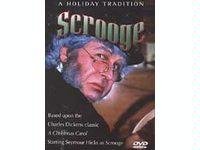| Actors: Oscar Asche, Donald Calthrop, Charles Carson, Robert Cochran, Maurice Evans Genres: Indie & Art House, Drama Sub-Genres: Indie & Art House, Drama Studio: Brentwood Home Video Format: DVD - Color - Closed-captioned DVD Release Date: 08/24/2004 Release Year: 2004 Run Time: 1hr 15min Screens: Color Number of Discs: 1 SwapaDVD Credits: 1 Total Copies: 0 Members Wishing: 0 MPAA Rating: NR (Not Rated) Languages: English See Also: |
Search - Scrooge on DVD
  | Scrooge Actors: Oscar Asche, Donald Calthrop, Charles Carson, Robert Cochran, Maurice Evans Genres: Indie & Art House, Drama NR 2004 1hr 15min This British production of Dickens's Christmas Carol has been eclipsed by subsequent versions, but it stands on its own as a darkly atmospheric (if sometimes regrettably brisk) telling of the beloved tale. Even with the ro... more » |
Larger Image |
Movie DetailsSimilar Movies
|
Movie ReviewsOne of the best film versions, and much better print than us Scott MacGillivray | Massachusetts, USA | 11/27/2002 (5 out of 5 stars) "This review refers to the 2002 DVD release on the "Image" label (orange and green jacket) with film elements from "The Blackhawk Films Collection." SCROOGE is the first sound version of Charles Dickens's "A Christmas Carol," filmed in England in 1935. I think this is one of the best screen adaptations of the story. Ebenezer Scrooge is played with Fieldsian grouchiness and ad-libbed asides by Sir Seymour Hicks, who had played the role on stage for decades, and he's terrific! (I suspect that Dickens scholar W. C. Fields caught some of Hicks's performances.) Donald Calthrop is the best Bob Cratchit I've ever seen; Robert Cochran is enjoyable as Scrooge's nephew Fred, and Philip Frost is cute as Tiny Tim. Director Henry Edwards deserves a round of applause for his careful handling of the story. The period detail is amazing, and the entire production is atmospheric and impressive. This version also goes a little deeper into story detail than most film versions (it's the only version I know in which Tiny Tim is shown in repose -- it's handled tastefully and sensitively by director and actors). For many years, all you could find on video was the abridged, hour-long version prepared for the educational market in 1941. (This shorter version is well edited and continues to be a budget-price video perennial.) Happily, this new DVD release derives from the original 1935 release, distributed theatrically in America by Paramount. There are about 20 more minutes of footage in this new restoration, and the picture and sound are excellent, definitely superior to the usual video versions that vary in quality. For those who are more familiar with the Alastair Sim and George C. Scott interpretations, give Sir Seymour a try. He'll make himself quite at home. If you're interested in the shorter version, it has been colorized. Amazon offers it here: Scrooge." Scrooge is still Seymour Hicks James R. Buck | Belleville, IL USA | 12/13/2007 (1 out of 5 stars) "Collectors of different interpretations of "A Christmas Carol" should beware. If you already own the Seymour Hicks version (available as Scrooge or as part of A Christmas Carol (Ultimate Collector's Edition)(B/W & Color)), you don't want this. It is the same film. Why Hicks' name is omitted in the cast listing at the top of this page, I don't know. The movie itself is not bad - I am rating it poorly because of the major omission in the cast listing." Don't let the low price fool you -- a good DVD! Sierra Donovan | Victorville, CA United States | 12/14/2001 (4 out of 5 stars) "There are several versions of this on DVD. This review is for the Front Row DVD. I'm happy to say that despite the cheap price, the disc is quite acceptable. There ARE a lot of scratches on the print, but the picture is sharp (for it's age) and the sound is very clear. Best of all, the film is complete. This same title is available from Marengo Films as a double feature, but it's missing 17 minutes of footage. (See my review for details.) As for the movie, it's not the best version of the story, but it's good and worthwhile for any Christmas Carol collection. It contains scenes on a ship and in a lighthouse that are taken from the book, but rarely filmed. It also has one scene that isn't in ANY other version -- Bob Cratchit mourning over the body of Tiny Tim, upstairs in their home. It's in the book, but a real surprise on film. On the other hand all but one of the ghosts is invisible. Oh well. Buy it anyway, and Merry Christmas!" The first sound version of the story James R. Buck | 12/03/1999 (3 out of 5 stars) "Although I've seen and treasured some of the other film versions of Charles Dicken's 'A CHRISTMAS CAROL', I still have some heart to this, the first sound version. It bolsters some fine performances by Donald Calthrop as Cratchit and Sir Seymour Hicks as Ebenezer Scrooge (Hicks had also played the role in a silent film, and at sixty-four, is probably the oldest of the many screen incarnations). The photography and production gives out a convincing Victorian atmosphere to the proceedings, and while I didn't like the idea of making Jacob Marley an invisible ghost, the cinematography does give some interesting touches to the visuals, like Scrooge's head superimposed on a large shadow of himself in the 'Christmas Yet to Come' sequences (For some reason, although Scrooge is dressed in pajamas when first visited, the ghostly journeys have him in his business clothes!). It's too bad that most of the video versions edit this film from its 78 minute length to an hour, removing several key scenes (Christmas Past continuing his presentation to Scrooge of how others celebrate Christmas, Tiny Tim saying 'God bless us, everyone!', etc.). Still, an interesting adaptation."
|








![Scrooge [Blu-ray]](https://nationalbookswap.com/dvd/s/18/8618/308618.jpg)
![A Christmas Carol [Blu-ray]](https://nationalbookswap.com/dvd/s/50/6650/256650.jpg)
